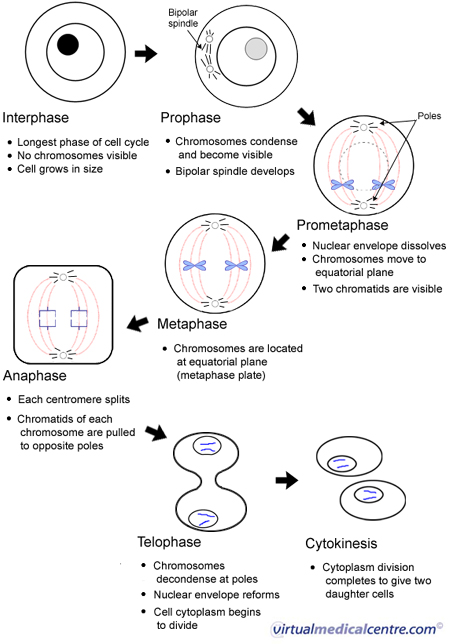How Dna Controls The Workings Of The Cell Answer Key
- Introduction to Deoxyribonucleic acid
- What is Deoxyribonucleic acid?
- Where is Dna constitute?
- What does DNA look like?
- Where does Dna come from?
- Why do cells divide?
- How do cells dissever?
- DNA replication
- Cell partitioning (mitosis)
- How does Dna control cellular functions?
- Protein synthesis
- Cell differentiation
- Dna abnormalities
- Not-disjunction
- Not-disjunction in the sex chromosomes
- DNA mutations
- Not-disjunction
- Genetic affliction
- Genetic diseases resulting from non-disjunction
- Cancer
- Take home messages
Introduction to Dna
 Humans are fabricated up of billions and billions of cells, all these cells working together in order maintain life. All our organs are made up of different types of cells, for example our largest organ, the pare, is made upwards of skins cells that are all tightly adhered together to office as a protective barrier for the residue of our body. The cells of the skin have different functions and characteristics than cells that brand upwardly our heart, or the ones that line our stomach. It is the specific functions of cells that permit us to live.
Humans are fabricated up of billions and billions of cells, all these cells working together in order maintain life. All our organs are made up of different types of cells, for example our largest organ, the pare, is made upwards of skins cells that are all tightly adhered together to office as a protective barrier for the residue of our body. The cells of the skin have different functions and characteristics than cells that brand upwardly our heart, or the ones that line our stomach. It is the specific functions of cells that permit us to live.
And so how do these cells perform certain functions? How does a new prison cell "know" that it is a skin jail cell and not a encephalon cell? And once it knows it is a skin cell how does it know how to perform functions that skin cells demand to do? And how does it know if it has been damaged by the sun and needs to exist replaced past another pare jail cell?
Well cells do not have a brain, so they do not "know" anything, they instead are controlled by a very of import chemical; deoxyribonucleic acid, or equally it is ameliorate known, DNA. Every characteristic, quality, role, appearance and location of a jail cell is determined by DNA, which ways that every characteristic, quality, function and appearance of our body is also determined past our unique Deoxyribonucleic acid.
What is Deoxyribonucleic acid?
Deoxyribonucleic acid is very complex and very tightly regulated chemical sequence that contains all the information our cells require to grow, perform functions and replicate. The information is contained in gene sequences, which are item stretches of chemical patterns within the Deoxyribonucleic acid that make upwards our genes.
So firstly, what are genes? Genes carry our hereditary characteristics. One factor is responsible for ane role in one type of cell. For instance one factor is responsible for our eye colour. This eye color factor sits on the same function of Deoxyribonucleic acid in every cell in the trunk however information technology is only the in the cells that make upwards the iris that that factor will be expressed. The same way that the gene that controls your heart shell will merely be expressed in the centre, although the cells in the iris volition too carry these genes.
All the genes and genetic information required for life contained in a jail cell is chosen the cell's genome. So y'all can imagine if each role of our cells and body is controlled by a separate gene then each of u.s.a. needs a lot of genes. The Human Genome Projection set out to determine only how many genes there are in our Deoxyribonucleic acid and what these genes are responsible for. In 2001 the showtime typhoon of the Man Genome Project was released; 30,000 genes were identified! The Man Genome Project or "mapping of human DNA" has been i of the nearly informative biological investigations. Knowing where genes exist inside the millions of chemicals that brand up DNA has helped to characterise genetic defects and diseases and how these diseases can exist treated or cured.
The genome is important in every attribute of cellular function, including cell structure, growth, motion and partition. Though nosotros all have a very like genetic brand upwardly that functions in like ways, there are lots of very small differences in our Dna and this is what makes each and every one of the states unique.
Where is DNA institute?
The aforementioned set of DNA is plant in the nucleus of every cell in our torso. The Dna is so tightly coiled and packed that information technology is estimated the nucleus of each human cell tin hold nearly 2 meters of DNA. The Dna exists in 46 split up segments within the nucleus; these segments are known equally chromosomes.
Each chromosome has a partner that contains the same genes in nearly the same sequence of Deoxyribonucleic acid, one member of the chromosome pair or homolog came from the male parent and one came from the mother during fertilisation. The chromosomes are what carry genes. An example of the genes carried by chromosomes are the sex genes, how the chromosome combination determines which gender you volition be will exist discussed afterwards on.

Information on re-publishing of our images
What does Dna expect like?
The shape of Deoxyribonucleic acid at the molecular level is idea to expect like a gently twisting ladder. Each of the rungs on the ladder represents a chemical bond between the chemicals that make up the Deoxyribonucleic acid molecule. These chemicals are called nucleotides and include:
- Adenine (A);
- Thymine (T);
- Cytosine (C); and
- Guanine (One thousand).
Deoxyribonucleic acid is said to be "double-stranded" considering it is made upward of two sequences of nucleotides that are tightly continued together by chemic bonds. The chemical bail between the nucleotides always exists betwixt A and T and G is always jump to C. For example;
- Strand 1: C – A – G – C – A – T – T – K
- Strand two: G – T – C – G – T – A – A – C
Chemic bonds exist between strand 1 and strand ii that connect the nucleotide pairs The strands are complimentary to one another, past knowing the sequence to 1 you can figure out the other because of the specific chemical bonds. The very long Dna strands are coiled very tightly into chromosomes.
Where does Deoxyribonucleic acid come from?
The sperm contains half the amount of chromosomes that be in other cells of the trunk and and so does the egg. Considering there are only 23 chromosomes in the sperm and the egg, they are known as haploid cells whereas every other cell in the body contains 46 chromosomes and are known equally diploid cells.
When the sperm fertilises the egg half of our chromosomes from our mother, maternal chromosomes, and half from our male parent, paternal chromosomes, are combined in the 1 jail cell (the egg) this is why nosotros share sure traits with either parent. For example, y'all may have blue eyes like your male parent, but have your mother's blonde hair.
23 chromosomes from the male parent have a chromosome pair with each of the 23 chromosomes from the mother. These pairs are referred to every bit homologs. The homologs comprise a very similar DNA sequence and therefore they contain the same gear up of genes. Nevertheless the paternal chromosome that contains the pilus structure cistron will contain an alternative version of this gene than the maternal chromosome; i may exist a curly hair gene whereas the other chromosome may comprise a straight hair factor. An allele is the name given to ane of these culling sets of genes.
Our Deoxyribonucleic acid is even further mixed up by a process called 'independent assortment' or 'chromosomal crossover' which change our genetic make up slightly and explain why siblings do non accept the same genetic brand-up, despite sharing the same parents. Cross-over occurs where segments of the one chromosome are replaced with the corresponding segment from its homolog and vice versa. Once all 46 chromosomes have paired up and cross-over has occurred then the cell divides.
Why do cells divide?
 Cells divide for a number of reasons. Firstly cells must separate in order to create life. Nosotros all start out equally a unmarried cell, this jail cell must divide, then divide once again then separate once again and again, to go the millions of cells that brand up the homo torso. As cells continue to divide they go the different cells in our body through a process called cell differentiation which volition exist discussed later on.
Cells divide for a number of reasons. Firstly cells must separate in order to create life. Nosotros all start out equally a unmarried cell, this jail cell must divide, then divide once again then separate once again and again, to go the millions of cells that brand up the homo torso. As cells continue to divide they go the different cells in our body through a process called cell differentiation which volition exist discussed later on.
Even afterward we have been born, cells in our body are continually dividing, and hence we abound and change. For example our peel cells have quite a rapid life cycle and are continuously being replaced past new cells. Cells need to be continually replaced considering all cells take a life cycle and they will eventually die. Cells die either because they just accept a short life cycle and are programmed to die or because they have become damaged and need to exist replaced in guild to avoid cancer formation.
How exercise cells divide?
When cells divide they undergo a process called mitosis. Before mitosis can occur all the same all the DNA needs to exist accurately replicated. Each chromosome is duplicated so that the jail cell contains two lots of Deoxyribonucleic acid. This Dna replication is necessary so that when the jail cell divides both cells volition have identical chromosomes and genetic information.
DNA replication
DNA replication is the duplication of all of a jail cell's genetic material. The double-stranded Deoxyribonucleic acid is "un-zipped' by an enzyme that exists in the cell nucleus chosen Dna helicase. The helicase breaks the chemical bonds between the nucleotides and the two complementary strands are separated, both these strands act as a "template" for replication. These strands are then duplicated nucleotide for nucleotide past another enzyme, DNA polymerase. The polymerase binds to the template and chemically attaches nucleotides to it in club to create a new complimentary strand to course an identical re-create of the original DNA molecule. As each template strand now has a new free Deoxyribonucleic acid strand attached to it, the prison cell contains 2 copies of the Dna. Every chromosome is replicated in this manner then the cell volition contain double copies of all of its DNA.
Cell partition (mitosis)
Mitosisis the division of a cell to form two identical daughter cells.
There are 7 phases of mitosis that are outlined in the figure below:

Information on re-publishing of our images
Cells are continuously replicating and dividing. The daughter cells formed from mitosis go on to replicate their DNA and divide into two more daughter cells and so on.
How does Deoxyribonucleic acid control cellular functions?
It is not the DNA itself that controls cellular functions, it is the proteins that are coded by the Dna. The nucleotide sequences that make upwards Dna are a "code" for the jail cell to make hundreds of different types of proteins; information technology is these proteins that function to control and regulate cell growth, partitioning, communication with other cells and nigh other cellular functions. This is why Dna is said to "carry" or "store" data in the class of nucleotide sequences.
The sequences need to exist "decoded" then translated in order to form the protein. This process is chosen protein synthesis.
Protein synthesis
Transcription is the first phase of protein synthesis. It is the procedure of reading the Deoxyribonucleic acid, this is carried out by enzymes inside the nucleus. The "transcript" from this process is another chemical molecule called messenger ribonucleic acid or mRNA. RNA is very similar to DNA in construction except information technology has but one strand compared to DNA which is double-stranded.
Translation is the second stage of poly peptide synthesis where the mRNA is translated into a protein. This involves another RNA molecule, transfer RNA (tRNA). tRNA matches iii nucleotides at a time from the mRNA. These 3-nucleotide sequence combinations are chosen codons. In that location are 64 possible combinations; for example
- G – A – C
- C – C – Thousand
- One thousand – Yard – G and so on.
Each of these codons lawmaking for a specific amino acid that is floating effectually freely within the nucleus. Amino acids are the very pocket-sized molecules that brand upward proteins. It is the tRNA molecule that binds these amino acids together as they are matched to the codon. Note there are only xx amino acids and 64 codons and then more i codon matches each amino acid.
Once this process is completed a functional protein is released to perform cellular functions. When a cell grows, communicates with other cells, excretes waste material, absorbs water, moves, sticks to other cells or dies (and much more) this is all due to the work of these proteins.
Cell differentiation
Equally we know, different cells take dissimilar functions and so not all cells will have the same proteins, nevertheless all cells accept the same Deoxyribonucleic acid. This leaves the question; how does one type of prison cell make different proteins from some other blazon of cell?
In order to answer this question it is helpful to think of DNA as a huge "instruction booklet". For unlike cells, different parts of the booklet are read and this is what differentiates one type of jail cell from another. For example our blood cells will read one chapter of this huge book. The next affiliate may be read past kidney cells and the next past liver cells and so on. So every cell type will transcribe and translate unlike genes that are independent in the DNA. A blood cell will "ignore" the department of DNA that codes for the eye color gene because claret cells do not demand the proteins that are involved in eye colour and vice versa.
Deoxyribonucleic acid abnormalities
 Genetic disorders or diseases are caused by particular genes or chromosomes abnormalities, sometimes these are inherited but they can also occur spontaneously during reproduction.
Genetic disorders or diseases are caused by particular genes or chromosomes abnormalities, sometimes these are inherited but they can also occur spontaneously during reproduction.
Not-disjunction
When meiosis occurs, the stage where the chromosome pairs separate and migrate to opposite sides of the jail cell ready for jail cell partition is a process called disjunction. Disjunction ensures each daughter cell receives its own copy of that chromosome. Non-disjunction occurs when the chromosomes neglect to seperate resulting in ane daughter cell with one as well many of the chromosome and one daughter cell with one too little. This can happen with the sexual practice chromosomes or any of the other chromosomes
Non-disjunction in the sexual activity chromosomes
As we discussed earlier, the sex activity of a growing embryo is adamant by the combination of genes passed on from our parents. When the egg divides one Ten chromosome is given to each of the daughter cells. The sperm then enters the egg conveying either an X or a Y chromosome. If the sperm is carrying an X, the cell will contain two X chromosomes and volition become a female. If the sperm is carrying a Y, the prison cell will accept an Ten and a Y and volition develop into a male. When this process is disturbed it can lead to a genetic abnormality.
Sometimes during cell sectionalization a sexual activity chromosome will fail to carve up grade its homolog and therefore when the cell divides 1 daughter cell will have no sex chromosome and the other volition have an extra chromosome, this dysfunctional stride during meiosis is called non-disjunction. This causes genetic abnormalities and tin can cause the growing foetus to die.
Dna mutations
Sometimes the DNA nucleotide sequence is altered and this is known equally a DNA mutation. Dna mutations can occur sponateously when mistakes are fabricated in the following cellular processes:
- Errors during replication; for example the Deoxyribonucleic acid polymerase could read an A instead of a C and hence add together a G instead of a T.
- Errors during transcription; or
- Errors during translation.
DNA mutations can also be caused past sure agents, these agents are chosen mutagens. Examples of mutagens include:
- Sunday;
- Alcohol;
- Cigarette smoke; and
- Some viruses.
Genetic disease
Genetic diseases resulting from non-disjunction
- Down syndrome: occurs when an actress chromosome 21 is passed on to a girl cell.
- Cystic fibrosis: caused by genetic defects in a specific cistron called CFTR.
- Turner syndrome: occurs when a second sexual practice chromosome is missing, leaving only one 10 chromosome. Girls with Turner syndrome often have a webbed neck and the ovaries are almost absent. If the sperm brings a Y chromosome the prison cell will dice.
- Klinefelter syndrome: occurs at that place is an extra X chromosome in the egg and the sperm brings a Y chromosome. The person will be a male with undeveloped testes and unusually large arms and legs.
- Triplo-X syndrome: occurs there is an actress X chromosome in the egg and the sperm brings a X chromosome. The person will exist an infertile female with some mild cerebral harm.
For more information on testing for genetic diseases meet genetic testing for hereditary diseases .
Cancer
Cancer is a disease that arises from mutations in genes.
Special areas of our DNA regulate how quickly our cells divide to brand new ones as we abound. If the DNA is mutated in some of these regulatory areas this can course the footing of a tumour, where cells brainstorm to carve up likewise quickly. For example there is 1 protein called the p53 tumour suppressor gene. p53 is activated when DNA is damaged by a mutagen and information technology fixes the damages. If a mutation occurs when p53 is being transcribed or translated information technology will not be able to office properly and hence when the DNA is damaged (from the sun for example) information technology volition non be fixed. This is ane instance when cancer can develop.
For more information on cancer cells see What Is Cancer?
Accept home messages
DNA, genes and chromosomes are very complicated and tin exist hard to understand when commencement reading about it. The chief points to remember are:
- Dna carries our genetic data
- Half our DNA comes from our mother and one-half from our male parent
- Deoxyribonucleic acid is packed into 46 chromosomes and the same 46 chromosomes are found in every prison cell in the body
- Dna needs to be transcribed and translated in guild to form proteins which conduct out cell functions
- Different cells will make different proteins and this is what differentiates one cell from some other
- When DNA is replicated or transcribed mistakes can be made and these are usually stock-still up, nonetheless when they aren't this tin can cause diseases such as cancer.
References
- Strachan T, Read AP. Human Molecular Genetics. Oxford: BIOS Scientific Publishers Ltd; 1996.
- DNA Structure and Function [Internet]. Partnership for Establish Genomics Education, University of California, Davis 2008 [cited 2008 July 21]. Available from URL: http://ppge.ucdavis.edu/ acrobat/ DNA_Structure_and_Function.pdf
- Elliott WH, Elliott DC. Biochemistry and Molecular Biology. tertiary ed. Oxford: Oxford University Press; 2005.
- Alberts B, Johnson A, Lewis J, Raff M, Roberts K, Walters P. Molecular Biological science Of The Cell. quaternary ed. New York: Garland Scientific discipline; 2002.
- Saladin KS. Anatomy & Physiology. 2nd Ed. New York, NY: McGraw Loma; 2001.
- Carter West, Bowen J. The Macquarie Habitation Guide to Health and Medicine. St Leonards, NSW: The Macquarie Library Pty Ltd; 1991.
All content and media on the HealthEngine Blog is created and published online for advisory purposes only. It is non intended to be a substitute for professional medical advice and should non be relied on as wellness or personal advice. Always seek the guidance of your md or other qualified health professional with any questions y'all may have regarding your health or a medical condition. Never disregard the advice of a medical professional person, or delay in seeking it considering of something y'all have read on this Website. If yous retrieve you may have a medical emergency, call your doctor, go to the nearest hospital emergency department, or phone call the emergency services immediately.
How Dna Controls The Workings Of The Cell Answer Key,
Source: https://healthinfo.healthengine.com.au/dna-deoxyribonucleic-acid
Posted by: kesslernecomanis.blogspot.com


0 Response to "How Dna Controls The Workings Of The Cell Answer Key"
Post a Comment